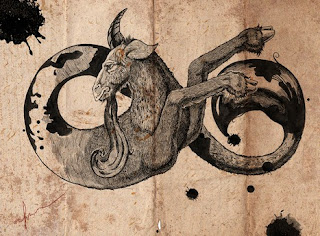Capricornus:Makar Rashi
Capricornus is a faint zodiac constellation located in the southern sky. Its name is for "horned goat" or "goat horn" or "having horns like a goat's" in Latin, and it is commonly represented in the form of a sea goat: a mythical creature that is half goat, half fish.
The constellation is located in an area of sky called the Sea or the Water, consisting of many water-related constellations such as Aquarius, Pisces and Eridanus. It is the smallest constellation in the zodiac.
In Greek mythology, the constellation is sometimes identified as Amalthea, the goat that nursed the infant Zeus after his mother, Rhea, saved him from being killed his father, Cronos.
Cronos had devoured his other children, all future gods and goddesses, because of a prophecy that said that he would be overthrown by one of them.
Amalthea's broken horn was transformed into the cornucopia or "horn of plenty"
In Greek mythology Cancer is known as the ‘Gate of Men’ where souls return to Earth to enter newborns, while Capricornus is known as the ‘Gate of the Gods’, where the souls of the dead return to heaven.
Pan had the legs and horns of a goat.
Pan dodged Typhon by jumping into the river Nile and turned the monster’s lower body into a fish, thus granting the chance for Zeus to kill it with thunderbolts.
In reference to the myth, Capricornus is commonly depicted as a goat with a fishtail..
Makara is a Sanskrit word which means "sea-animal, crocodile".
It is the origin of the Hindi word for crocodile, मगर (magar), which has in turn been loaned into English as the name of the Mugger crocodile, the most common crocodile in India.
Makara appears as the vahana (vehicle) of the river goddess Ganga, Narmada and of the sea god Varuna.
Makara are considered guardians of gateways and thresholds, protecting throne rooms as well as entryways to temples; it is the most commonly recurring creature in Hindu architecture.










Nice one😊😊👍👍👌👌
ReplyDelete